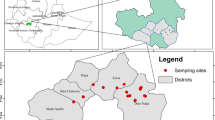Abstract
To protect the reservoir water quality, it is required to control and reduce the pollution sources in its upstream watershed area. This study applies the EPA’s Storm Water Management Model and the Vollenweider model to assess the relationship between the pollution sources in the Luliao Reservoir Watershed and the water quality of the Luliao Reservoir. The purpose of this study is to determine the total maximum daily loads in the watershed on the basis of a target water quality concentration of the receiving waterbody. The results show that the allowable total phosphorous (TP) load is about 855 kg/yr when considering a target TP concentration of 24 μg/L. To reach this target, the TP load needs to have about 1222 kg/yr reduction. Moreover, this study analyzes the spatial variation of TP load and the pollution hotspots in the Luliao Reservoir Watershed. The pollution control and reduction strategies are recommended to preferentially implement in the pollution hotspots.




Similar content being viewed by others
References
Beeton AM, Edmondson WT (1972) The eutrophication problem. J Fish Board Can 29(6):673–682
Borah DK, Yagow G, Saleh A, Barnes PL, Rosenthal W, Krug EC, Hauck LM (2006) Sediment and nutrient modeling for TMDL development and implementation. Trans ASABE 49(4):967–986
Boyacioglu H, Alpaslan MN (2008) Total maximum daily load (TMDL) based sustainable basin growth and management strategy. Environ Monit Assess 146(1):411–421
Carlson RE (1977) A trophic state index for lakes. Limnol Oceanogr 22(2):361–369
Chang CL, Liu HC (2015) Applying the Back-Propagation Neural Network model and fuzzy classification to evaluate the trophic status of a reservoir system. Environ Monit Assess 187(9):567
Chen CF, Tsai LY, Fan CH, Lin JY (2016) Using exceedance probability to determine total maximum daily loads for reservoir water quality management. Water 8(11):541
Conley DJ, Paerl HW, Howarth RW, Boesch DF, Seitzinger SP, Havens KE, Lancelot C, Likens GE (2009) Controlling eutrophication: nitrogen and phosphorus. Science 323(5917):1014–1015
Cooke GD, Welch EB, Peterson S, Nichols SA (2016) Restoration and management of lakes and reservoirs. CRC Press, Boca Raton
Damodaram C, Giacomoni MH, Prakash Khedun C, Holmes H, Ryan A, Saour W, Zechman EM (2010) Simulation of combined best management practices and low impact development for sustainable stormwater management. J Am Water Resour Assoc 46(5):907–918
D’Arcy B, Frost A (2001) The role of best management practices in alleviating water quality problems associated with diffuse pollution. Sci Total Environ 265(1):359–367
DePinto JV, Freedman PL, Dilks DM, Larson WM (2004) Models quantify the total maximum daily load process. J Environ Eng 130(6):703–713
Dillon PJ, Rigler FH (1974) A test of a simple nutrient budget model predicting the phosphorus concentration in lake water. J Fish Board Can 31(11):1771–1778
Gironás J, Roesner LA, Rossman LA, Davis J (2010) A new applications manual for the Storm Water Management Model (SWMM). Environ Model Softw 25(6):813–814
Jarosiewicz A, Ficek D, Zapadka T (2011) Eutrophication parameters and Carlson-type trophic state indices in selected Pomeranian lakes. Limnol Rev 11(1):15–23
Jha MK, Wolter CF, Schilling KE, Gassman PW (2010) Assessment of total maximum daily load implementation strategies for nitrate impairment of the Raccoon River, Iowa. J Environ Qual 39(4):1317–1327
Kirchner WB, Dillon PJ (1975) An empirical method of estimating the retention of phosphorus in lakes. Water Resour Res 11(1):182–183
Kojiri T (2008) Importance and necessity of integrated river basin management. Phys Chem Earth Parts A/B/C 33(5):278–283
Kratzer CR, Brezonik PL (1981) A Carlson-type trophic state index for nitrogen in Florida lakes. J Am Water Resour Assoc 17(4):713–715
Liu R, Zhang P, Wang X, Chen Y, Shen Z (2013) Assessment of effects of best management practices on agricultural non-point source pollution in Xiangxi River watershed. Agric Water Manag 117:9–18
Mostaghimi S, Brannan KM, Dillaha TA, Bruggeman AC (2000) Best management practices for non-point source pollution control: selection and assessment. In: Ritter WF, Shirmohammadi A (eds) Agricultural Non-point Source Pollution. LEWIS Publishers, London, pp 257–304
Rast W, Thornton JA (1996) Trends in eutrophication research and control. Hydrol Process 10(2):295–313
Rosa DJ, Clausen JC, Dietz ME (2015) Calibration and verification of SWMM for low impact development. J Am Water Resour Assoc 51(3):746–757
Said A, Sehlke G, Stevens DK, Glover T, Sorensen D, Walker W, Hardy T (2006) Exploring an innovative watershed management approach: from feasibility to sustainability. Energy 31(13):2373–2386
Schindler DW (2006) Recent advances in the understanding and management of eutrophication. Limnol Oceanogr 51(1):356–363
Smith VH, Schindler DW (2009) Eutrophication science: Where do we go from here? Trends Ecol Evol 24(4):201–207
Steinman AD, Ogdahl ME (2015) TMDL reevaluation: reconciling internal phosphorus load reductions in a eutrophic lake. Lake Reserv Manag 31(2):115–126
Tsai LY, Chen CF, Fan CH, Lin JY (2017) Using the HSPF and SWMM models in a high pervious watershed and estimating their parameter sensitivity. Water 9(10):780
Vollenweider RA (1971) Scientific fundamentals of the eutrophication of lakes and flowing waters, with particular reference to nitrogen and phosphorus as factors in eutrophication. Organisation for economic co-operation and development, Paris
Wang C, Bi J, Ambrose RB (2015) Development and application of mathematical models to support total maximum daily load for the Taihu Lake’s influent rivers, China. Ecol Eng 83:258–267
Wu Y, Chen J (2013) Investigating the effects of point source and nonpoint source pollution on the water quality of the East River (Dongjiang) in South China. Ecol Ind 32:294–304
Acknowledgements
The authors would like to thank the National Science Council of the Republic of China for financially supporting this research under Contract No. MOST 106-2621-M-035-001.
Author information
Authors and Affiliations
Corresponding author
Additional information
Editorial responsibility: Necip Atar.
Rights and permissions
About this article
Cite this article
Chang, CL., Hong, TY. Applying environmental models to determine total maximum daily loads for reservoir watershed management. Int. J. Environ. Sci. Technol. 16, 5635–5642 (2019). https://doi.org/10.1007/s13762-018-2115-y
Received:
Revised:
Accepted:
Published:
Issue Date:
DOI: https://doi.org/10.1007/s13762-018-2115-y




